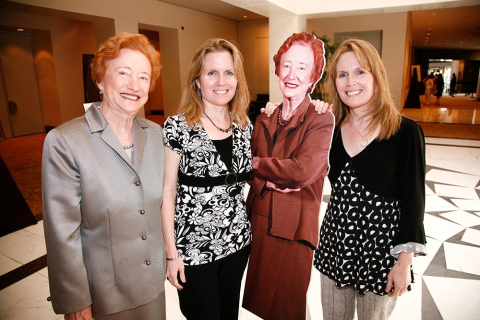

PATRICIA L. STARCK
PhD, RN, FAAN - DEAN, 1984-2015
Many of Cizik School of Nursing’s successes over the past 50 years rest on the legacy of its longest-serving steward, Dean Emerita Patricia L. Starck, PhD, RN, FAAN. In her 30 years at the helm, Starck elevated the school from “the best kept secret in the Texas Medical Center” to a nationally ranked leader in nursing education, practice, and research.
“She is a dynamo,” said Associate Professor Barbara K. Bailes, EdD, RN. “She instituted a lot of innovations and moved the school forward faster than most leaders could.”
Early inspirations
Starck grew up in Americus, Georgia, among a large, extended family with a tradition of sending boys to medical school and girls to nursing school. At the time, most nurses attended diploma schools within hospitals, but Starck understood the value of higher education. She started at the local community college, now Georgia Southwestern State University (whose alumni include Jimmy and Rosalynn Carter). She then earned bachelor’s and master’s degrees in nursing from Emory University in Atlanta.
Starck became interested in rehabilitation while still in nursing school. “It started with a cousin of mine who at age 17 became quadriplegic,” she said. “That was devastating for him and his family. I saw what they went through.” Between degrees, she worked as a rehab nurse for an insurance company, helping people with workers’ compensation injuries.
These experiences led her to a lifelong research focus on ways to alleviate suffering, from both a physical and psychological standpoint. Her work focused on the undertreatment of pain and on logotherapy, a future-focused approach that helps people find meaning in life. She eventually received a lifetime achievement award from the Victor Frankl Institute, whose namesake pioneered logotherapy.
Starck turned to teaching after marrying Emory medical student Jim Starck. At the time, nurses needed only BSNs to teach in hospital diploma schools, but Starck pursued her MSN. For the next dozen years, she worked and taught in hospitals and colleges in Georgia, Florida, and Colorado.
“I really loved teaching because I quickly realized that if I’m a nurse, I’m affecting one patient at time. When I am a faculty member and I’m teaching 20 students, I’m really affecting 20 students’ future patients at a time,” she said.
By the time she started working on her doctoral degree, Starck was the widowed mother of twin daughters in junior high. The three would study together over the dinner table in an apartment near the University of Alabama in Birmingham.
Excelling at jobs she didn’t ask for
Twice in her life, Starck became a dean of nursing when she only aspired to be an assistant dean. The first was at Troy State University in Alabama, a small school with a big reputation for educating members of the military. She learned valuable lessons working among retired majors and generals, but by the time her daughters, Jaime Catherine and Patricia Ann, started college, Starck was ready for a new challenge.
“I really missed being where the clinical action was,” she said. “I was tired of reading about medical discoveries in the paper and not being at the place where they were happening.”
Starck again sought an assistant dean position to learn the ropes. However, Billye J. Brown, EdD, RN, then dean of The University of Texas at Austin School of Nursing, encouraged her to consider the deanship in Houston. Starck decided to stop off on her way home from an interview in California.
Grappling with statewide austerity measures in the wake of property tax reforms, the California school she visited assigned her a dorm room for the night. UTHealth Houston put her up in a suite at the Shamrock Hilton. It was no contest. The family moved to the Bayou City, with mom at UTHealth Houston and the twins at Rice University.
“I really liked Dr. Roger Bulger, who was the university president at the time,” she said. “The nursing school, when I came, was not very well known. I think Dr. Bulger’s position was, ‘We have so much potential here. It’s not been activated.’”
Starck wanted to better integrate faculty and students into Houston hospitals, so expanding faculty practice became one of her first priorities. This helped faculty keep their skills sharp, provided access to patient populations for research, and offered more clinical placement opportunities for students.
A home for nursing education
The need for a better teaching space also became clear early on. In the historic Houston Main Building, the nursing school occupied the fifth, sixth, and 15th floors, and that separation hindered unity.
Eventually, students presented a petition complaining about one particularly noisy and poorly air-conditioned classroom. Thus began the years-long adventure of designing the nursing school’s new home. Two architectural firms and many, many stakeholder meetings later, the eight-story structure designed specifically for nursing education opened in October 2004 at 6901 Bertner Ave. Built for the future – not only of nursing education but of sustainable construction – the “green” building earned LEED® Gold certification in 2009.
“This was the time when online education was just being whispered, so we were trying to predict what education would look like in the coming years for this building,” Starck said. “The things we did were cutting-edge in our classrooms. We had electrical outlets everywhere for students to plug in their computers.”
The building stands as a physical representation, but only one example, of Starck’s innovative mindset. Under her leadership, the school grew in size and stature, from offering only BSN and MSN degrees to a DNP, a PhD, and multiple specialty concentrations. In addition, the first nurse practitioner clinic, UT Health Services, was started and led for many years by Thomas Mackey, PhD, RN, FAAN.
“We had administrative support all the way down for trying things,” said Professor Emerita Sharon K. Ostwald, PhD, RN. “If we had an idea that seemed good, it would be supported and facilitated.”
Fighting for programs
However, advancements rarely came easily.
“One of the most important things for the school was our getting approval from the Texas Higher Education Coordinating Board for our first doctoral program, and then for the DNP and the other programs,” Starck said. Despite fierce opposition at every turn, the nursing school prevailed with strong support from the physicians and other schools at UTHealth Houston.
“Pat Starck never took no for an answer,” Ostwald said.
Starck marks among her proudest accomplishments the successful matriculation of two cohorts of accelerated PhD students. To address the nursing shortage, more faculty were needed to educate more students. So, Starck and members of the school’s advisory council worked with local hospitals to secure funding to enable PhD students to go to school full-time and graduate in three years. The students committed to serve as UTHealth Houston nursing faculty for four years after graduation and to conduct research at the sponsoring hospital. They also brought students to the hospitals for clinical rotations. Each new PhD student who became faculty could support an increase in enrollment of 10 undergraduate students.
“This was a program we designed that was actually a win-win-win all the way around,” Starck said. Several of the students who earned their PhDs through that program still teach at Cizik School of Nursing today.
Starck served the wider UTHealth Houston community in her later years at the university. From 2011 to 2013, she wore two hats as dean of the nursing school and senior vice president for community affairs for the university. This assignment followed her success in establishing the PARTNERS organization, a committed group of volunteers who have raised money for scholarships, professorships, and research support as well as building and equipment needs for decades. Starck held the community affairs position temporarily until Kevin J. Foyle, MBA, was hired to lead the university’s development efforts.
Retirement?
In 2014, Starck announced her retirement from the nursing school but dedicated another two years to UTHealth Houston as senior vice president for interprofessional education. She led an initiative to bring students from the university’s six schools together for learning experiences that would help them function more effectively as integrated teams.
Starck still keeps very busy. She wrote a recently published book chapter on logotherapy and is putting the finishing touches on a novel based on family stories from the early 1900s.
One of her greatest joys is being cared for by UTHealth Houston nursing alums when she has encountered health problems.
“Just recently, I asked a nurse anesthetist what year she graduated, then asked, ‘Do you remember Dean Starck?’ After an enthusiastic response, I said, ‘Well, that’s me,’” the dean emerita recounted. “I’m so proud of the contributions our graduates are making.”
As in the days of her childhood, Starck is surrounded by close family. She, her daughters, and their husbands live in adjacent houses. The grandchildren who grew up running through their backyards are now grown, and Starck recently met her first great-grandchild.
The pandemic temporarily limited family interactions to phone calls and conversations through windows, but Starck has no complaints.
“I’ve got plenty of projects and things to do,” she said.
Dean Starck shares highlights of her three decades at Cizik School of Nursing in video excerpts from an oral history interview.





